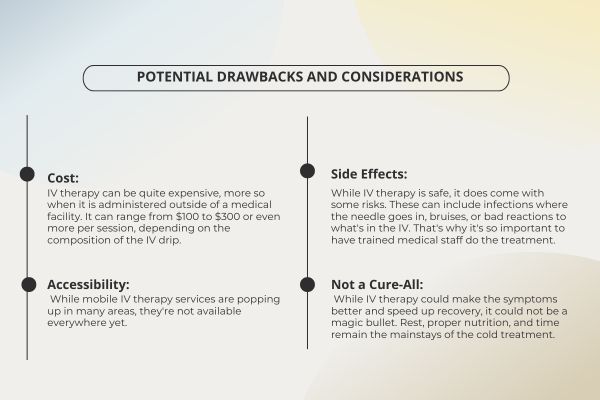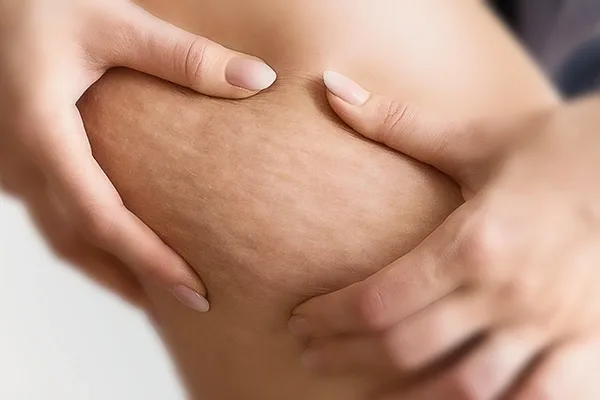Does an IV Drip for a Cold Speed Up Recovery?
An IV drip for a cold can help alleviate symptoms and support faster recovery by:
Rapid Hydration – Replenishes lost fluids to boost immune function.
Essential Nutrients – Delivers vitamin C, B vitamins, and zinc directly into the bloodstream.
Symptom Relief – Can include medications to ease nausea, headaches, and body aches.
Immune Support – Strengthens the body’s defenses for a quicker bounce-back.
While not a cure, an IV drip for a cold can provide quick relief, especially for those with severe symptoms or busy schedules.
As cold season hits, so many make a mad dash for quick and effective means to alleviate the suffering. Whereas most revert to traditional approaches like rest, hydration, and over-the-counter medications, IV therapy has been an increasingly growing trend in treating the common cold. But does the potential for a cold to be remedied by an IV therapy even exist? This article will delve into the possible advantages that come with it, its scientific basis, and whether or not it is worth such an approach.

Traditional Cold Remedies
Most people get through their cold symptoms with over-the-counter medications, including decongestants, pain relievers, and antihistamines. Staying hydrated, getting plenty of rest, and taking immune-boosting nutrients like vitamin C and zinc are other highly recommended activities. However, none of these remedies speeds up a person’s recovery; they are usually aimed at symptom management. That is where IV therapy has gained prominence as one potential path people take when they want quicker relief and want to get back to normal living fast.
How IV Therapy Could Help with a Cold
Rapid Rehydration:
One easily gets dehydrated during a cold, particularly if one has a fever, overproduction of mucus, or loss of appetite. Adequate hydration is important for the proper activity of the immune system. IV fluids infused into the body help to quickly rehydrate the lost fluids and electrolytes so that the body becomes well-hydrated enough to fight off the infection more effectively.
- Direct Nutrition: IV therapy delivers key vitamins and minerals straight into the bloodstream skipping the digestive system. This helps people who can’t eat or drink due to a sore throat or feeling sick. IV treatments for colds often contain:
- Vitamin C: While known for its cold-fighting properties, high doses can help in reducing cold symptoms and can cut down on the length of colds.
- B Vitamins: They fight fatigue and increase energy levels; it is quite vital when one is suffering from a cold.
- Zinc: Zinc is an established mineral that possibly helps reduce the duration of a cold, if taken at the first signs of illness.
- Magnesium and glutathione: these antioxidants can help the immune system carry out its function and enable the body to rebound more easily from illness.
Symptom Relief:
Other than hydration and nutrition, IV therapy can also be infused with medications that directly attack cold symptoms. For example, antiemetics may reduce nausea, and anti-inflammatories help reduce body aches and headaches. This kind of tailored approach gives treatment broad coverage by treating several symptoms at the same time.
Immune System Boost:
IV therapy can boost the body’s natural defenses by injecting immune-supporting nutrients straight into the bloodstream. While pills and capsules might take a while to kick in, and a troubled digestive system could mess with how well they work, IV therapy gives your body the most bang for its nutritional buck.
Types of IV Therapy for Colds
There are two primary types of IV therapy commonly used for cold and flu symptoms: IV Push and IV Drip.
- IV Push: A small amount of fluid is injected directly into the vein quickly; generally, it takes 15-20 minutes. This is a rapid administration of vitamins and medications when time is essential.
- IV Drip: This one is more gradual, providing larger volumes over 45-60 minutes. As the IV drip releases the hydration, vitamins, and medications at a steady stream for absorption into the body, the patient can just relax.
Read about dermal fillers and thread lifts in Elegant Hoopoe website.
Is IV Therapy for Colds Effective?
Even though there is anecdotal evidence and growing popularity of IV therapy for colds, one has to realize that scientific studies regarding its effectiveness are still rather scarce. While nutrients can definitely help the body recover, they do not cure a cold. The biggest advantages are in quicker alleviation from its symptoms and hydration, which would definitely produce an easier way to live with the cold.
Who Can Benefit from IV Therapy for a Cold?
IV therapy for colds may be particularly beneficial for:
- More Serious Cases: Those experiencing very bad congestion or dehydration or are just extremely tired may do better with an IV to bring quicker relief.
- Busy professionals: With IV therapy, people that can’t afford to be away from the workforce too long now have a quick way to get well again and back in action.
- Weakened immunes: IV therapy can give that extra boost of nutrition to people with underlying health conditions or weakened immune systems.
Potential Drawbacks and Considerations

Despite its potential benefits, IV therapy for colds isn’t for everyone. Some considerations include:
- Cost: IV therapy can be quite expensive, more so when it is administered outside of a medical facility. It can range from $100 to $300 or even more per session, depending on the composition of the IV drip.
- Accessibility: While mobile IV therapy services are popping up in many areas, they’re not available everywhere yet.
- Side Effects: While IV therapy is safe, it does come with some risks. These can include infections where the needle goes in, bruises, or bad reactions to what’s in the IV. That’s why it’s so important to have trained medical staff do the treatment.
- Not a Cure-All: While IV therapy could make the symptoms better and speed up recovery, it could not be a magic bullet. Rest, proper nutrition, and time remain the mainstays of the cold treatment.
Additionally, for IV therapy for cancer patients can be used to deliver essential nutrients and hydration that might help alleviate side effects and support overall well-being during their recovery journey.
Conclusion:
IV therapy can certainly help relieve cold symptoms by providing rapid hydration, essential nutrients, and medication for specific symptoms. Otherwise, it is an option when a person has serious symptoms, leads a busy life, or suffers from other health concerns. On the other hand, for many other people, this is not a requirement and traditional treatments are quite effective. If you’re considering IV therapy, you should talk to a healthcare professional about whether it’s right for you.
In summary, an IV can make any cold substantially better by rehydrating and refueling the body much faster and more effectively than by oral means, but it’s not a fix. Many are greatly improved by the ease and speed of IV therapy in feeling better during recovery, though for others, standard care methods will suffice. It’s all about weighing benefits with cost and potential risks associated with health decisions.







